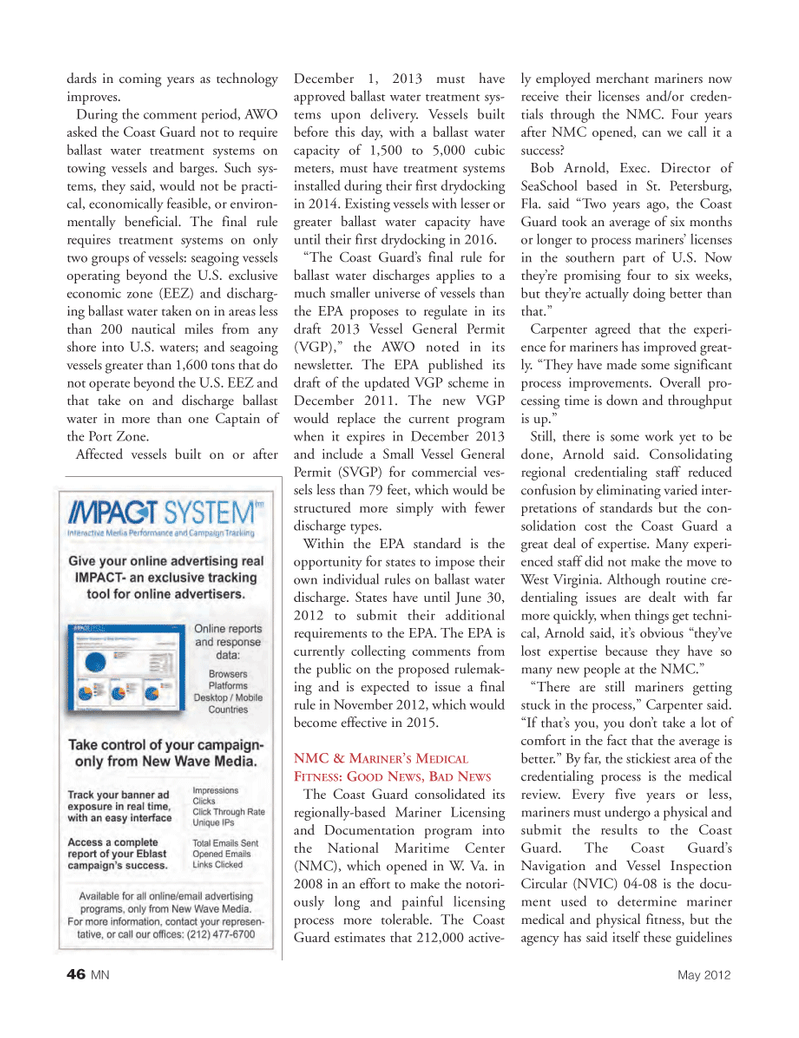
Page 46: of Marine News Magazine (May 2012)
Combat Craft Annual
Read this page in Pdf, Flash or Html5 edition of May 2012 Marine News Magazine
46MNMay 2012dards in coming years as technology improves. During the comment period, AWO asked the Coast Guard not to require ballast water treatment systems on towing vessels and barges. Such sys- tems, they said, would not be practi-cal, economically feasible, or environ- mentally beneficial. The final rule requires treatment systems on only two groups of vessels: seagoing vessels operating beyond the U.S. exclusive economic zone (EEZ) and discharg- ing ballast water taken on in areas less than 200 nautical miles from any shore into U.S. waters; and seagoing vessels greater than 1,600 tons that do not operate beyond the U.S. EEZ and that take on and discharge ballastwater in more than one Captain of the Port Zone. Affected vessels built on or after December 1, 2013 must have approved ballast water treatment sys- tems upon delivery. Vessels built before this day, with a ballast water capacity of 1,500 to 5,000 cubicmeters, must have treatment systems installed during their first drydocking in 2014. Existing vessels with lesser or greater ballast water capacity have until their first drydocking in 2016. ?The Coast Guard?s final rule for ballast water discharges applies to amuch smaller universe of vessels than the EPA proposes to regulate in its draft 2013 Vessel General Permit (VGP),? the AWO noted in its newsletter. The EPA published its draft of the updated VGP scheme in December 2011. The new VGP would replace the current program when it expires in December 2013 and include a Small Vessel General Permit (SVGP) for commercial ves- sels less than 79 feet, which would bestructured more simply with fewer discharge types.Within the EPA standard is the opportunity for states to impose their own individual rules on ballast water discharge. States have until June 30, 2012 to submit their additionalrequirements to the EPA. The EPA is currently collecting comments from the public on the proposed rulemak- ing and is expected to issue a finalrule in November 2012, which would become effective in 2015. NMC & MARINER?SMEDICALFITNESS: GOODNEWS , BADNEWS The Coast Guard consolidated its regionally-based Mariner Licensing and Documentation program into the National Maritime Center (NMC), which opened in W. Va. in 2008 in an effort to make the notori- ously long and painful licensingprocess more tolerable. The Coast Guard estimates that 212,000 active- ly employed merchant mariners now receive their licenses and/or creden- tials through the NMC. Four years after NMC opened, can we call it a success? Bob Arnold, Exec. Director of SeaSchool based in St. Petersburg, Fla. said ?Two years ago, the Coast Guard took an average of six months or longer to process mariners? licenses in the southern part of U.S. Now they?re promising four to six weeks, but they?re actually doing better than that.?Carpenter agreed that the experi- ence for mariners has improved great- ly. ?They have made some significant process improvements. Overall pro- cessing time is down and throughput is up.? Still, there is some work yet to be done, Arnold said. Consolidatingregional credentialing staff reduced confusion by eliminating varied inter- pretations of standards but the con- solidation cost the Coast Guard a great deal of expertise. Many experi- enced staff did not make the move to West Virginia. Although routine cre- dentialing issues are dealt with far more quickly, when things get techni- cal, Arnold said, it?s obvious ?they?ve lost expertise because they have so many new people at the NMC.? ?There are still mariners getting stuck in the process,? Carpenter said. ?If that?s you, you don?t take a lot of comfort in the fact that the average is better.? By far, the stickiest area of the credentialing process is the medical review. Every five years or less, mariners must undergo a physical andsubmit the results to the Coast Guard. The Coast Guard?s Navigation and Vessel Inspection Circular (NVIC) 04-08 is the docu- ment used to determine marinermedical and physical fitness, but theagency has said itself these guidelinesMN#5 (32-49):MN 2011 Layouts 5/7/2012 12:16 PM Page 46

 45
45

 47
47
